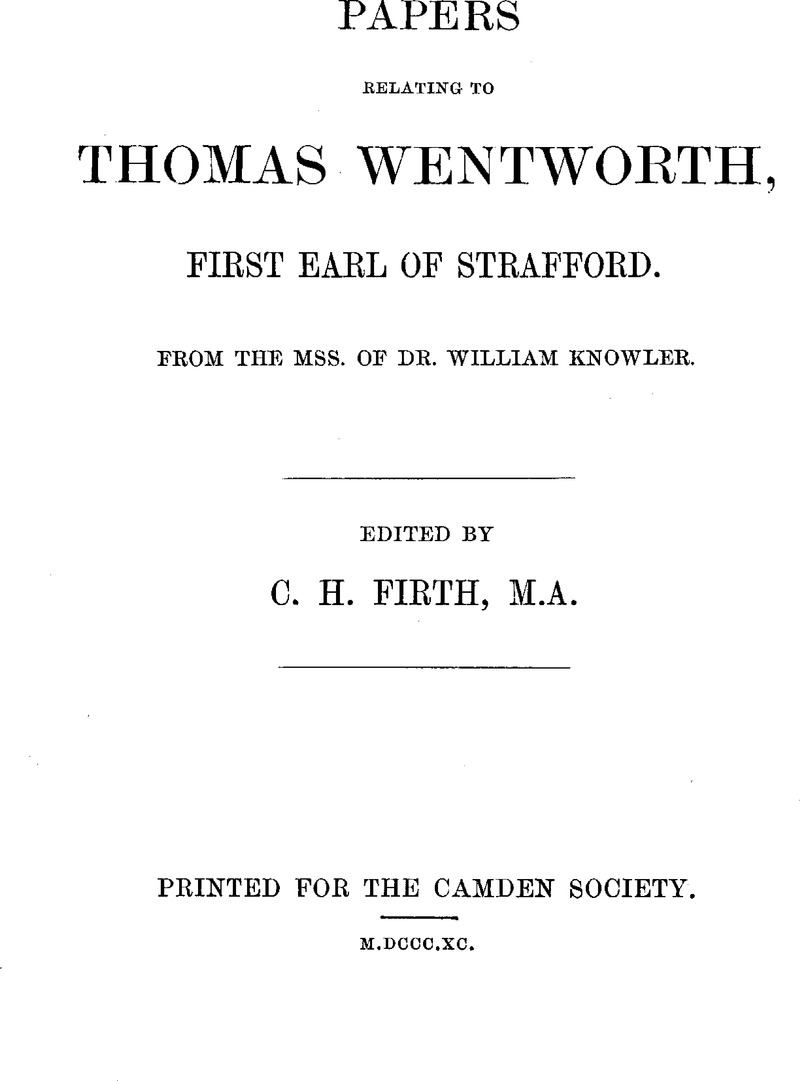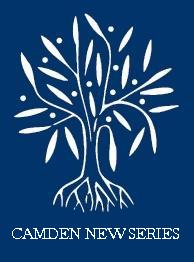No CrossRef data available.
Article contents
Papers Relating to Thomas Wentworth, First Earl of Strafford
Published online by Cambridge University Press: 24 December 2009
Abstract

- Type
- Other
- Information
- Copyright
- Copyright © Royal Historical Society 1985
References
page v note a Rev. John Knowler, LL.D. m. 1749, Mary Dalton.
Mary Knowler m. 1772, Edward Derby, of Boddick, Oxon.
Mary Derby m. 1806, Rev. John Hyde, Rector of St. Martin's, Oxford.
Edward Hyde m. 1836, Rachel Early.
Anne Hyde m. Rev. T. W. Openshaw.
page v note b Dr. Knowler's keys to the cyphers employed in Strafford's letters are now in the Bodleian Library.
page v note c Sir John Wentworth, of North Elmsal, Yorkshire, was created a baronet July 28, 1692, and died April 25, 1720, aged 47. The family of Wentworth of North Elmsal was an early offshoot of the family of Wentworth Woodhouse, to which Strafford belonged (Hunter, South Yorkshire, ii. pp. 82, 451). The late Lord Strafford referred to is William, second Earl, who died in 1695 (Collins, ix. 410).
page vii note a Memoirs of the most material transactions in England for the last hundred year preceding the Kevolution in 1688, by James Welwood, M.D. 1700, p. 48.
page ix note a The authenticity of the letter is attacked by Carte, Life of Ormond, ed. 1851, vol. i. pp. 275-278. He affirms it to be a forgery, and quotes a report that the second Earl of Strafford used to say that his father told him, on the night before his death, that “he had never wrote any such letter, and that it was a mere forgery of his enemies, in order to misguide th e King to consent to his death.” But the evidence of Sir George Radcliffe is conclusive proof of its genuineness. See Gardiner, History of England, ix. 361, where the question is discussed.
page x note a As the originals are at present inaccessible, a list of those letters which are not in the printed collection is subjoined:—
(1). The Lord Deputy to the Lord Keeper upon his requesting that Lord Holland might be examined as a witness in the Star Chamber case betwixt him and Sir Piers Crosby, dated Dublin, Dec. 10, 1638.
(2). To the Lord Keeper, 16 April, 1639, on the same subject.
(3). To the Lord Admiral, April 15, 1639.
(4). To Lord Cottington, April 16, 1639.
(5). To Sir Henry Vane, Dublin, April 29, 1639.
(6). To Sir Henry Vane, Dublin, 14 May, 1639.
(7). 24th May, Strafford to — (no address).
(8). To the Lord Admiral, 26 May, 1639, Dublin.
(9). To Sir H. Vane, Dublin, 30 May, 1639.
page xi note a The notion that the Queen was instrumental to Strafford's death is founded on the mistaken belief that she was his enemy; any hostility to Strafford on her part had ceased to exist long before his trial. See Gardiner, History of England, ix. 366.
a See Stafford Letters, i. 11, where this letter was originally to have been printed. On second thoughts Dr. Knowler, or possibly Lord Malton, decided to omit it.
a John Mohun of Boconnock, Cornwall, was created Lord Mohun of Okehampton, co. Devon, 15 April, 1628, and died in 1644 (Dugdale Baronage, p. 461). See Forster's Life of Sir John Eliot, passim. The cause mentioned is the suit between Wentworth and Sir David Foulis. See Rushworth, ii. 215; Strafford Letters, i. 146,167.
a The Strafford Letters contain the Lord Deputy's answer to this letter, which is addressed to the King (i. 477; see also pp. 449, 459, 479).
a Copied by Goddard from Sir John Wentworth's papera and sent to Dr. Knowler; see preface, p. ix.
a This letter was sent by Henry Goddard to Dr. Knowler; ee preface, pp. vi., ix. The list of letters which he gives includes several to Vane and Northumberland, printed in vol. ii. of the Strafford Papers.
Lord Holland had for some time been hostile to Wentworth, and had carried stories against him to the King (Strafford Letters, ii. 125, 189). He objected to be examined as a witness in Wentworth's case against Sir Piers Crosby in the Star Chamber, and pleaded his privilege as a Privy-councillor (ibid., 230, 277). Though he was finally compelled by the King's command to give evidence, it does not appear t o have been of much value (p 307). See the reports of Crosby's case, Rushworth, vol. iii. 888–900, Cal. State Papers, Dom. 1639. Wentworth had also just received from the Earl of Northumberland, then Lord Admiral, the news that, thanks to the influence of the Queen and the Marquis of Hamilton, Holland had been made General of the Horse, for the northern expedition, in place of Essex (Strafford Letters, ii. 276). With reference to Wilmot, an old opponent of the Lord Deputy, the latter observes in a letter to Northumberland, “The endeavoures I bear to bring in my Lord Wilmot and some are pleased to affect it the rather, as that which would much displease me” (ibid., p. 280).
page 10 note a Note by Mr. Goddard:
“N.B. The words above in the King, tho' writ exactly as I have transcribed them, i n the copy, I look upon as a wise remark of Sir John Wentworth's by way of explanation.”
page 10 note b i.e. the Marquis of Hamilton.
a “Among Milton's introductions at Geneva through Diodate or otherwise was one to the family of Camillo Cerdogni or Cardouin, a Neapolitan nobleman, who had been resident in Geneva since 1608 as a Protestant refugee and a teacher in Italian. The family kept an album, in which they liked to collect autographs of strangers passing through the city, and especially of English strangers. Many Englishmen, and some Scotchmen, predecessors of Milton in the usual continental tour, had already left their signatures in this album, and among them no less a man than Wentworth, whose autograph appears in it under date 1612” (Masson, Life of Milton, i. 833, ed. 1881). The album, according to Professor Masson, was once in the possession of Charles Sumner, and is still in America. Stafford's motto is from Seneca. Pope was fond of quoting the same lines (Courthope's Life of Pope, p. 72).
a The Constable of the Tower.
a As I did not meet with this letter till after the others had been printed off, it has been necessary to place it after the Index.


